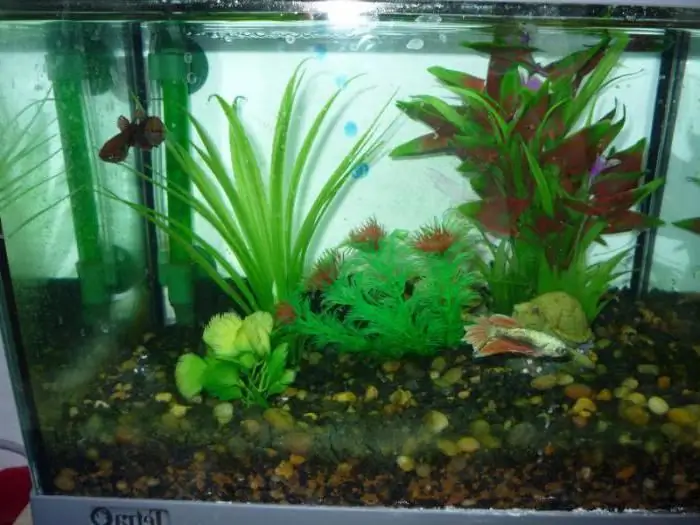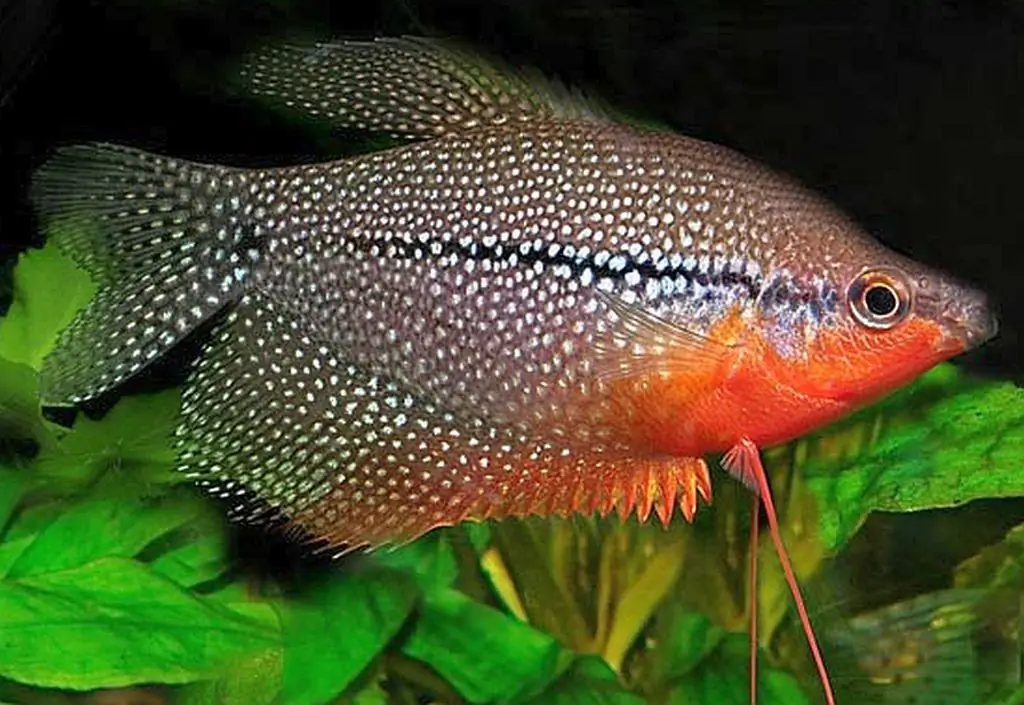2026 Author: Priscilla Miln | [email protected]. Last modified: 2025-01-22 17:55:24
Jellyfish are graceful and spectacular marine life. The smooth movements of these animals are fascinating. Many aquarists dream of having such an unusual pet in their home. How to choose and maintain an aquarium with jellyfish, you will learn from this article.

About jellyfish
The transparent jellyfish we see in the sea are just part of the life cycle of coelenterates. They are characterized by two stages: polypoid and medusoid. Adult sexually mature jellyfish reproduce sexually. The result is larvae - planula, floating in the water column for several days.
Planulae attach to the substrate and transform into a polyp. It is noteworthy that even in the immobile stage, these animals reproduce by budding. Asexual reproduction can continue indefinitely, and jellyfish can only appear in favorable conditions.
When the temperature rises, as a result of the strobilation process, small young disc jellyfish are formed, which are called ethers. Over time, they become adults.
Bodyjellyfish is transparent, resembles jelly and consists of 99% water. At the same time, the skeleton is absent, as well as the protective covers of the body, so they are very vulnerable. Their delicate body is easily destroyed. Any dense object, even a small air bubble, can inflict a wound. Strong currents and waves of water are also dangerous. That is why jellyfish swim away to the depths when a storm approaches.

Jellyfish Aquarium Features
Attempts to keep jellyfish in the aquarium have been carried out for a long time, but were unsuccessful. Jellyfish turned out to be too tender and sensitive pets. In an ordinary aquarium, they quickly died, and until recently it was believed that it was impossible to keep jellyfish at home.
However, not so long ago, carousel-type aquariums began to appear on the market, which allow you to keep the most sensitive animals. They were developed on research vessels that studied marine life. Initially, containers of this type were intended to contain planktonic organisms.
Keeping jellyfish at home became possible only after the release of carousel-type aquariums to the mass market. The peculiarity of their functioning is that a closed annular flow of water is created in the tank. Such an aquarium has a round shape and looks like a drum of a washing machine. Do you want to buy a similar aquarium with jellyfish? The price of the smallest container starts from 50 thousand rubles.

Real Kreisel-aquarium
The carousel-type aquarium is shaped like a drum. A closed current of water is organized inside, allowing fragile creatures to move in its thickness. The flow exits through a narrow outlet parallel to the wall, the liquid is sucked through a wall protected by a dense mesh.
At the top is a lid through which you can feed the jellyfish, clean the aquarium, change the water. There is a drain at the bottom through which liquid can be drained.
Pseudokreisel-aquarium
There are pseudocarousel aquariums that have the shape of a rectangle. In such containers, some carousel-type structural elements are used. A closed water flow is organized in the same way as in a round container. In order for the flow to go in a ring, washing all the walls of the aquarium, special chippers are installed in the corners. In terms of quality, such aquariums are inferior to carousel ones, since the water flow is disturbed on straight walls, and eddies can form.

Aeration
Thanks to the organization of the laminar type of water circulation, jellyfish can be suspended throughout the volume of the aquarium. The speed of the water flow is important so that the bodies of tender jellyfish are not injured. At the same time, the current must be fast enough so that the animals do not sink to the bottom and get stuck in the "dead zones".
In no case should there be aeration in an aquarium with jellyfish. If small air bubbles get under the dome of the jellyfish, they will simply tear it apart like bullets. In an aerated aquarium, the animal will quickly die. For jellyfish it will be enough to providenormal gas exchange at the surface of the water. And if aeration is planned for decorative purposes, then the bubbles must be securely separated from the main tank where the jellyfish live.
Filtering
Filtration is also not a necessary element in the jellyfish. Regular water changes will be sufficient to keep the water clean. However, you can install a simple life support system. The main thing is to protect the jellyfish from being sucked into the filters. Biological filtration that does not create air bubbles is most preferred. But skimmers are not recommended to be placed in an aquarium with jellyfish, as they can become a source of deadly bubbles and too actively remove substances necessary for the life of animals.
Jellyfish live in the open sea, where the water is somewhat poorer in dissolved and suspended solids than offshore and reefs. And in a confined space, waste products quickly decompose, polluting the water. Therefore, timely replacement and purification of water is essential.
Since jellyfish are cold-water animals, the water in the aquarium must be cooled. The comfortable temperature is 10-15°C, so any aquarium should have a built-in cooler.

Lighting
Some species of jellyfish (Mastigias and Cassiopeia) contain symbiotic algae in their tissues. In this case, they will need lighting so that the plants can receive the light necessary for life. Other types of jellyfish do not require lighting. Animals can move towards the light, sohow they take it for a food source - an accumulation of plankton.
Jellyfish are best kept in low light, this will prevent green plaque from appearing on the walls. The aquarium with live jellyfish looks great with colorful lights.
Where to get inhabitants
It will not be difficult to buy an aquarium with a jellyfish in the region. Moscow is no exception. Inhabitants can be bought in several stores in single copies. If you need a group of animals, they will have to be brought to order. In other regions, you will also have to order jellyfish separately. The most common in stores are Cassiopeia and Mastigias. These warm water jellyfish thrive in the aquarium.
If you live by the sea, then you can catch a jellyfish yourself. Several suitable species of jellyfish, in particular the eared aurelia, are found in the White and Black Seas. It should be borne in mind that White Sea jellyfish prefer colder water. Young animals 5-10 cm in diameter are suitable for keeping in captivity, as they will easily adapt to new conditions. Freshwater jellyfish for an aquarium can be found in rivers. You can catch them during the hot summer.

Transportation of jellyfish
Transportation of jellyfish is a very responsible event. It doesn't matter if you bought the animals from the store or caught them from the sea. If the transportation is done incorrectly, the jellyfish may be injured. The animal must be placed in a large plastic bag or plastic form with smoothed corners, filled to the top with water. From the container you needremove all air. If air bubbles appear in the water when shaking, they can break the dome of the jellyfish.
How to transport jellyfish
Never take the animal out of the water. Any manipulations need to be done only under water. A beginner should also be placed in an aquarium with jellyfish along with liquid. Keep cold water jellyfish from overheating during transport.
Types of jellyfish
Who fill the aquarium with jellyfish? The most popular species is the eared aurelia. It lives everywhere, in almost all tropical and temperate seas, swimming even in the waters of the Arctic. Sometimes representatives of this species gather in large groups. She does not have long tentacles, which means that animals will fit in small containers. They are hardy, easily adapt to new conditions, their stinging cells are not dangerous to humans. Eared aurelias live for 2 years.
More exotic aquarium species include the Pacific resident Mastigias papua, the long-tentacled beauty Chrysaora and the magnificent spotted Australian jellyfish, whose dome resembles a starry sky. Jellyfish of the genus Mastigias are easy to keep and have interesting behavior. Suitable for beginners and representatives of the genus Cassiopeia, which can be kept even in ordinary aquariums due to their sedentary lifestyle.

Feeding jellyfish
To make jellyfish feel comfortable and live a long life, you need to feed them with a variety of foods. Most often, live brine shrimp are used as feed andvitamin supplements. In nature, jellyfish feed on phyto- and zooplankton, which can be replaced by minced seafood. Fish and shrimp are rare in the diet, so you should not give them often.
Decorative jellyfish for aquarium
So, you already understood that keeping live jellyfish is a troublesome and costly business. They cannot be settled in a common aquarium, moreover, the container with these animals should be empty and decorated only with backlight. However, your home underwater world can complement the silicone jellyfish for the aquarium.
Such an unusual decoration can be purchased at a pet store. Artificial jellyfish for the aquarium are attached to the glass with a fishing line. They are bright and interestingly behave in the moving water column.
The maintenance of live jellyfish in an aquarium is still a few that can afford. Most often, these beauties can be seen in aquariums, hotel lobbies, restaurants. If you want to decorate your home aquarium with a small bright jellyfish, you can purchase an artificial one.
Recommended:
Aquarium fish algae eater: description, content features, care and reviews

Not all novice aquarists know that in addition to fish, snails, natural or artificial greenery and decorative ornaments, an algae-eating fish should settle in every underwater kingdom. About why the presence of these inhabitants is so necessary, we will try to tell in this article
Gourami: spawning, reproduction, description with photo, life cycle, characteristic features and content features

Gourami are extremely popular and easy to keep freshwater fish. Their reproduction is easy to achieve in captivity. For spawning, gourami fish make small nests. Consider the most popular types of gourami, features of their content, natural range, reproduction
Aquarium pangasius: name, description with photo, breeding, content features, rules of care and feeding

The aquarium pangasius attracts many aquarists with its unusual appearance. In stores, their fry are sold as ornamental fish, while often silent about the problems that the new owner may face. In particular, it is often silent about the size that this fish reaches, regardless of the volumes in which it lives
Piranha natterera: description and features of the content in the aquarium

Piranha Natterera is a beautiful, but relatively little-known aquarium fish in our country. It is quite difficult to maintain, but an experienced marine life lover will surely take up such an interesting challenge with pleasure
Aquarium fish: comet. Description, photo and content features

Purely outwardly, the comet is quite similar to an ordinary goldfish. At least her standard color is exactly the same. But, of course, there is a fairly significant difference between these two types

